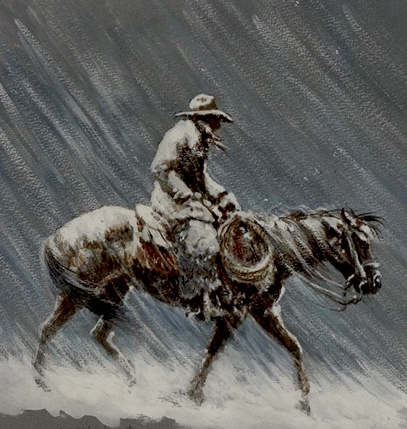
Watercolor by Olaf Wiefhorst
In Evidence-Based Horsemanship, Martin Black describes a daunting scenario:
One night, I was riding in the dark and two feet of snow. It was overcast, so there was no moon or starlight. Not even the silhouette of the horse’s head could be seen against the snow. We were traveling on a road but could not see the shoulder. We had to trust the horses to bring us home.
I did have a sense that at some point we would come to a cattle guard that was across the road, under the snow.
Our horses came to a sudden stop and refused some encouragement to continue forward. I got off and felt under the snow with my foot the rails of the cattle guard, just a few strides in front of my horse.
They knew that under two feet of snow, there were steel rails covering a deep hole. They had stopped clear of it. I felt my way to the end of the rails and found the gatepost, but still could not see that my hand was touching it.

Head directions cells rely on feedback from the inner ear
When EBH was published, we didn’t know much about the complex of neurons that make up animals’ internal mapping system. While Black’s horse may have indeed used its superior vision to navigate that stormy night, it also may have relied on boundary cells, head direction cells, place cells, and grid cells.
Read more about place cells and grid cells in Part I.
A Refresher Note on the complex of mapping neurons:
- Place cells fire when an animal returns to specific locations.
- Grid cells fire in a hexagonal, overlaying fashion and tell an animal where it is in relation to other points.
- Boundary cells note environmental boundaries (more on these cells and how they may have enabled Black’s horse below)
Head direction cells:

My horse, Comet says, “Home is that way”
And, she’s right.
Head direction cells are located in the entorhinal cortex, as well as the thalamus and striatum. Unlike place, grid, and boundary cells, these cells depend on input from the vestibular system, which helps us balance and tells us where we are in space. The cells rely less on visual cues and instead depend on inner ear feedback.
When a horse comes into an environment for the first time, the alignment of the head direction cell system is arbitrary. But after it begins to explore and fire place cells and grid cells, neuronal landmarks will begin to be associated with course. When the horse returns to that environment, the learned associations will engage head direction cells.
Head direction cells increase their firing when the horse’s head is oriented in a specific, familiar direction. The cells fire more rapidly when the head is oriented in the same or exactly opposite direction as during prior experiences. In other words, your horse knows his ‘north’ and his ‘south,’ his ‘out’ and his ‘back.’
Or, consider another scenario:
You and your horse are a half-mile from home and you’re riding on a big, circular path around the home pasture, which is out of sight. You may find that his head is consistently turned towards home, adjusting automatically to his position in relation to it.
Some head direction cells exhibit anticipatory movement involving the thalamus and motor system, preparing the horse for an impending head turn.
Boundary cells (also called border or vector cells) are neurons in the hippocampus that fire when an environmental boundary – a wall, a fence, a cliff, a cattle guard – is a certain distance from the horse. These cells are also found in the entorhinal cortex and together with grid cells, head direction cells, and place cells make up this mutually excitatory feedback system.
Together, this complex of neurons creates and maintains a mental map of the horse’s environment in real time (and, as has been noted by researchers, may be replayed during moments of dwelling).
One more thing:
Some research shows that these mapping neural connections are strengthened by reward. When a goal (like finding hay and buddies at home) is reached, the connections between the mapping cells and the motor command cells are reinforced. Read more about dopamine rewards here.

Try dropping the reins. Your horse likely knows the way much better than you.